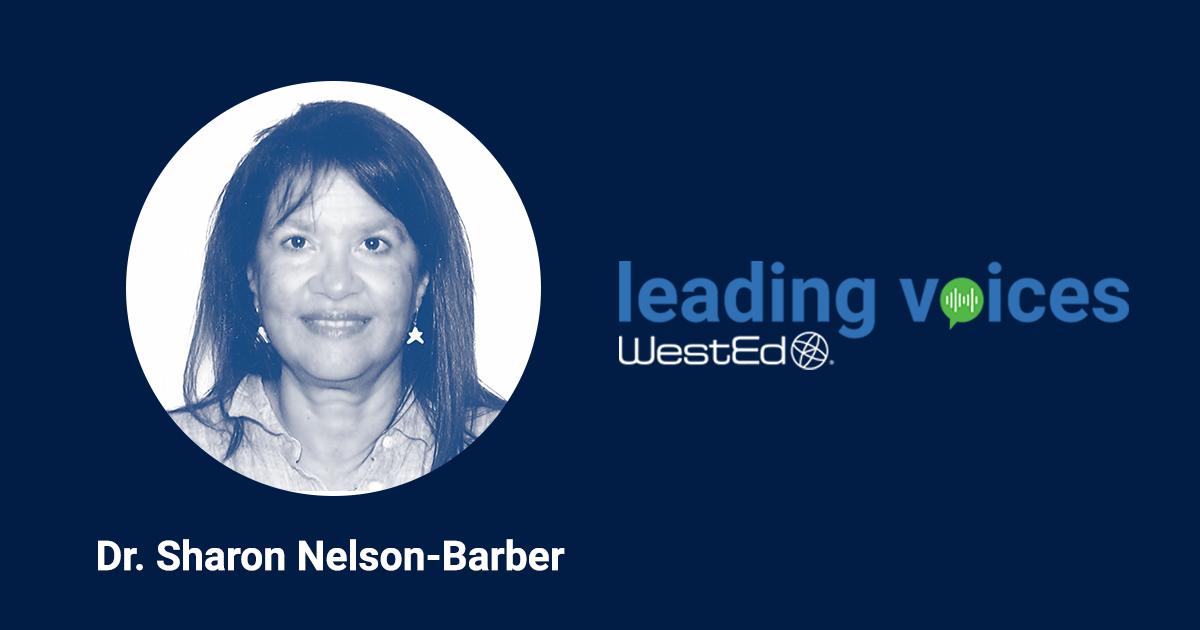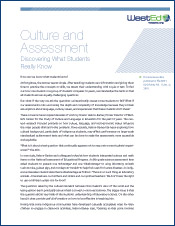Dr. Sharon Nelson-Barber: Infusing Mainstream STEM Education With Indigenous Culture, Language, and Values
Posted on

This article first appeared on Scientia and appears here with permission.
In the United States, approaches to science, technology, engineering, and math (STEM) instruction are aligned with English-speaking, White middle-class norms. STEM courses rarely reflect consideration for the unique backgrounds of Indigenous learners. Because of this devaluing of local cultural, linguistic, and community traditions, whole communities are left behind, resulting in learners’ exclusion from advanced educational and employment tracks.
Dr. Sharon Nelson-Barber, Director of Culture and Language in STEM Education at WestEd, aims to change this trajectory. She and her team explore the ways in which students’ cultural backgrounds influence how they learn STEM subjects. Based on the team’s findings, they have developed innovative STEM education and assessment methods that shift relationships between Indigenous ways of learning and Western educational practices.
Integrating Indigenous and Minoritized Cultures in STEM
Ensuring that STEM courses are compatible with the linguistic needs and unique cultural backgrounds of all students is of utmost importance to Dr. Nelson-Barber. She believes that finding ways to support diverse teachers and learners to bridge worldviews will help learners realize their academic potential while also enriching the STEM community with a broader range of perspectives.
Minoritized groups such as Indigenous populations are still widely underrepresented in scientific and engineering fields. This is largely because most STEM education courses in the United States implicitly represent White, mainstream cultural perspectives, with little regard for diverse concepts and knowledge systems. Many students from minoritized backgrounds, including many Indigenous students, do not “see” themselves or their ways of knowing represented in conventional academic curricula. Such curricula, which typically reflect cultural values and heritage that these students do not share, also effectively perpetuate the systemic inequalities that disenfranchise them.
Working With Indigenous Communities
Dr. Nelson-Barber, of Rappahannock Indian and African American descent, has lifelong personal and professional experience with this work. As Director of Culture and Language in STEM Education at WestEd, she has dedicated most of her career to better understanding how students’ cultural backgrounds influence how they make sense of STEM subjects. Her research proposes valuable methods for incorporating diverse perspectives, values, and languages in STEM teaching and assessment practices. Common misconceptions that reduce the validity of assessment outcomes include underestimating students’ English proficiency, overestimating their heritage language proficiency, and lowering academic expectations as a result.
In spite of colonization and aggressive assimilation intended to extinguish heritage languages and identities, Indigenous communities continue to maintain knowledge systems that are coherent and complete unto themselves, including values, norms, and lifeways. As noted by Dr. Nelson-Barber and her colleague Dr. Zanette Johnson in 2016, when mainstream assumptions are encoded into educational norms, this poses challenges for Indigenous students, who must be the ones to bridge the gap in areas such as community values, worldview, environmental knowledge, socioeconomic status, and teacher/student roles.
It is profoundly unjust that Indigenous students have had to bear the constant weight of adapting to U.S. conventional norms in order to succeed in educational spaces. Educational researchers and instructors must now be the ones to shoulder responsibility for expanding the range of learning opportunities that are accessible to students of all backgrounds.
To better understand how students with distinct cultural backgrounds approach and relate to STEM disciplines, Dr. Nelson-Barber engages with educators, elders, and other local knowledge keepers. These individuals have a deep understanding of their communities and insights about how their cultural values can be incorporated in instruction to positively impact students’ learning.
“Our work highlights the need to work side by side with community members who carry the linguistic, cultural, and institutional knowledge of their communities,” says Dr. Nelson-Barber. “My team approaches this research knowing that the community members are the real experts in their domain; we each lend our unique perspectives about valued outcomes.”
STEM Interventions for Indigenous Students
With classrooms becoming increasingly diverse, and technology and science advancing at an increasingly rapid pace, educators must turn to local excellence for assistance in adapting academic approaches that will better equip students to face future challenges. Dr. Nelson-Barber and her team regularly codevelop and try out new teaching approaches side by side with Indigenous community members and educators.
Drawing upon research to design effective STEM instruction is important, but best practices identified on the basis of research with culturally “mainstream” students may have limited utility in informing STEM instruction for Indigenous students. These so-called “best practices” often work best for White middle-class learners, since they do not consider the students’ linguistic and cultural backgrounds, nor do these education methods draw on beliefs, values, or goals outside the mainstream or require family or community involvement.
Over a 3-year period, Dr. Nelson-Barber and Dr. Johnson interviewed practicing Diné educators who were earning master’s degrees and Native language teaching certifications. The researchers learned about the extent to which some “proven” research-based STEM education methods actually limited students’ academic performance because it suppressed their cultural values and vitality. Diné teachers also held that involving families in their children’s schooling was a beneficial approach for their students, though it does not necessarily apply to students from White majority backgrounds. This could be a reflection of lingering fallout from the colonial ways of “educating” Indigenous people, which involved aggressive learning programs that were intended to erase Native cultures, replacing them with those of the colonizers, as well as differences in cultural values.
The forced removal of youth from homes and communities to boarding schools interrupted the natural acquisition of language and culture for generations. Returning youth, denied their language, could no longer interact with grandparents and community elders, removing important cultural learning, and directly contributing to the erasure of cultural and community knowledge. Assimilationist practices embedded in current school reforms continue to disregard students’ Native languages, cultural differences, dialectal protocols, cultural traumas, and social hierarchies.
As a result of this program, administrators have been learning about the many benefits of incorporating heritage language and local ways of knowing in everyday teaching practices. The Diné teachers described ways that they infused their instruction with “context-adaptive” approaches. Examples include linking scientific knowledge with activities that are part of students’ cultural heritage, such as sheep herding and weather prediction, or integrating local nonverbal and visual communication styles and allowing students to speak in heritage language. All of these methods contributed to improved long-term learning and knowledge consolidation.
STEM has always been robustly alive in their world of everyday activity—we want Indigenous learners’ knowledge to be valued, visible, and valid within the fields of STEM study and practice. And that vision begins now, with teachers crafting classroom learning that bridges knowledge systems and opens generative space for cultural identity, language, and practice within school.
Context-Adaptive Learning Methods
In 2016, Dr. Nelson-Barber and her colleagues started adapting technology-based science learning tools in close collaboration with Indigenous educators from the Navajo Nation and Hawai‘i. The educators explained the deep impact that historical trauma associated with colonization still has on how Indigenous peoples experience formal education in public schools. “Many of my Native colleagues talk about the heavy psychological price they paid growing up when asked to leave identity at the classroom threshold in exchange for an education,” says Dr. Nelson-Barber. “They needed to become someone else—someone who would step up to learn, and speak, and behave the ‘right’ way.”
Over several years of research, Dr. Nelson-Barber and her team identified context-adaptive methods for conducting research and teaching students in culturally diverse learning environments. One method involved adapting FieldScope, an online citizen science tool to support project-based learning outdoors. Teachers developed STEM instruction that reflected Indigenous cultural values, including a respect for the deep meaning of land, and incorporated an understanding of spiritual relationships among people and the land and natural resources.
Dr. Nelson-Barber and her colleagues devised a new instructional aid to support the lesson adaptations: a descriptive rubric that details key aspects of teaching in Indigenous cultural contexts. The tool organizes teacher knowledge around eight crucial factors for learners in Indigenous settings: contextualization, critical self-reflection, cultural values, land-based and nature-based learning experiences, the preservation of Native languages, family and community bonds, cognitive complexity, and authentic assessment. It delineates strategies and communication styles that are more relatable for students since they create space for weaving with local values and traditions.
With the adaptations to the FieldScope platform and a new instructional model in hand, educators of Indigenous learners have a new research-based resource to help students make sense of scientific concepts in familiar and culturally relevant ways.
Culturally Appropriate Assessments
In addition to supporting teachers as they augment teaching with innovative new context-adaptive teaching approaches and resources, Dr. Nelson-Barber and her colleagues have been devising more valid methods to assess STEM learning of students from Indigenous and minority backgrounds.
Through her collaborations with Indigenous educators, Dr. Nelson-Barber knows the importance of recognizing meaningful connections between topics covered in class and teachers’ own Native heritage, ancestors, land, culture, and communities. Toward this goal of understanding how learners bridge worldviews, the work is premised on the principle that there are different cultural representations and ways of understanding science. This ultimately creates space for students to understand how they can apply what they have learned within their cultural context and to potentially envision a career in STEM.
Dr. Nelson-Barber is also developing alternative STEM testing tools that account for linguistic differences. For instance, as many existing tests have unnecessary syntactic complexity, she has been developing syntactically straightforward tests to reliably assess middle school and high school students’ understanding of mathematics and science concepts.
Tackling Glocal Challenges
The recent work carried out by Dr. Nelson-Barber and her colleagues will have far-reaching implications for the academic development of students from Indigenous communities and potentially to other minoritized groups as well. In addition to identifying context-adaptive STEM teaching and assessment methods, which teachers can use to account for differences in language, culture, heritage, and values, some of her projects are directly supporting students from Indigenous communities.
Dr. Nelson-Barber is currently involved in studying “science identity” development among university students in geoscience research programs focused on coastal science. This project engages learners from the U.S. Virgin Islands, Puerto Rico, Guam, the Northern Mariana Islands, Palau, the Federated States of Micronesia, and the Marshall Islands. Over the course of 5 years, numerous middle school, high school, college-level, and graduate students from these islands are participating in a variety of programs by conducting authentic, original STEM research alongside university faculty. The project has supported summer camps, graduate training courses, professional development workshops, scientific conferences, and other programming all aimed at welcoming islanders to the STEM community.
This project, along with numerous other projects by Dr. Nelson-Barber and her collaborators, will ultimately help to build a more diverse STEM workforce, supporting Indigenous communities as they tackle the climate crisis and future environmental challenges using approaches that center different perspectives. Toward this goal, Dr. Nelson-Barber also cofounded POLARIS (Pivotal Opportunities to Learn, Advance, and Research Indigenous Systems)—a research and development network that encourages a deep transformation in STEM education, promotes the preservation of Indigenous values and cultures, and addresses climate change and other local and global (glocal) scientific challenges.
Dr. Nelson-Barber offers this reflection in closing: “For millennia, the Indigenous communities we work with have been engaged in learning science, engineering, math, and technology; sustainability and knowledge of the environment are at the core of these learners’ life experiences. We, as educators, are learning from them about how to support learners in bringing their valuable knowledge to the fore—and reshaping the discipline of ‘science’ so that it is more diverse, accessible, and relevant. STEM has always been robustly alive in their world of everyday activity—we want Indigenous learners’ knowledge to be valued, visible, and valid within the fields of STEM study and practice. And that vision begins now, with teachers crafting classroom learning that bridges knowledge systems and opens generative space for cultural identity, language, and practice within school.”

